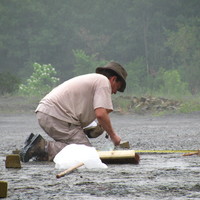Investigating the deep supercooling ability of an Alaskan beetle, Cucujus clavipes puniceus, via high throughput proteomics
Journal of Proteomics, 2012
Cucujus clavipes puniceus is a freeze avoiding beetle capable of surviving the long, extremely co... more Cucujus clavipes puniceus is a freeze avoiding beetle capable of surviving the long, extremely cold winters of the Interior of Alaska. Previous studies showed that some individuals typically supercool to mean values of approximately -40 °C, with some individuals supercooling to as low as -58 °C, but these non-deep supercooling (NDSC) individuals eventually freeze if temperatures drop below this. However, other larvae, especially if exposed to very cold temperatures, supercool even further. These deep supercooling (DSC) individuals do not freeze even if cooled to -100 °C. In addition, the body water of the DSC larvae vitrifies (turns to a glass) at glass transition temperatures of -58 to -70 °C. This study examines the proteomes of DSC and NDSC larvae to assess proteins that may contribute to or inhibit the DSC trait. Using high throughput proteomics, we identified 138 proteins and 513 Gene Ontology categories in the DSC group and 104 proteins and 573 GO categories in the NDSC group. GO categories enriched in DSC include alcohol metabolic process, cellular component morphogenesis, monosaccharide metabolic process, regulation of biological quality, extracellular region, structural molecule activity, and antioxidant activity. Proteins unique to DSC include alpha casein precursor, alpha-actinin, vimentin, tropomyosin, beta-lactoglobulin, immunoglobulins, tubulin, cuticle proteins and endothelins.











Uploads
Papers by T. Sformo